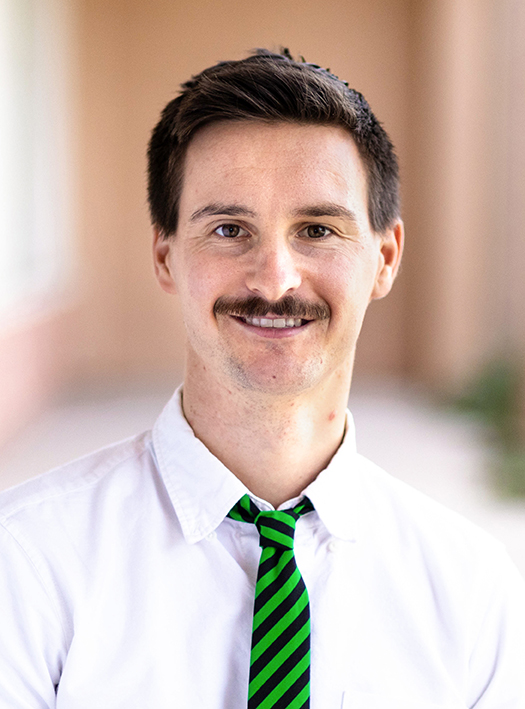UNM nuclear engineer leading over $1 million in funding for two Department of Energy projects
June 26, 2023 - by Kim Delker
A faculty member from The University of New Mexico Department of Nuclear Engineering is the lead on two grants from the U.S. Department of Energy’s Nuclear Energy University Programs that total more than $1 million.

Eric Lang, an assistant professor of nuclear engineering, is the principal investigator on the two new projects that will improve nuclear reactor performance and future development.
These projects were part of two recent funding announcements by the Department of Energy. One was about more than $56 million in nuclear energy projects and student innovation awards across the country that will support nuclear technology development, early career faculty research activities, and student research. The other announcement was about $6.3 million for projects involving scientific infrastructure and upgrades research reactors at universities to expand the nation’s scientific capabilities, and train the next generation of nuclear energy scientists and engineers.
“I am pleased to see The University of New Mexico leading the way in the groundbreaking research that will help us develop next-generation nuclear microreactors,” said U.S. Sen. Martin Heinrich, who represents New Mexico. “UNM is also working in close partnership with our national labs to train the next generation of nuclear engineers and scientists. These exciting research investments are further proof that New Mexico remains at the heart of important advances in nuclear technologies.”
The first project involving UNM, called “Deciphering Irradiation Effects of YH through In-situ Evaluation and Micromechanics for Microreactor Applications,” is funded for $998,000 through the Advanced Reactor Development program.
Lang is collaborating with Caitlin Kohnert and Aditya Shivprasad, both of Los Alamos National Laboratory, and Khalid Hattar of the University of Tennessee at Knoxville.
This project will investigate the use of yttrium hydride (YH) to slow down or moderate neutrons in microreactors (defined as reactors that produce about 2-20 megawatts of power). Moderating neutrons in reactors is an essential process for efficient use of fuel. Currently, neutrons are moderated by water, but Lang said that water has two primary disadvantages: it loses effectiveness at high temperatures and is corrosive. By using YH, the potential exists to operate smaller reactors as well as develop next-generation reactor designs, such as microreactors for remote locations and self-contained reactors for small communities.
He said that there was some research around a half-century ago to explore the use of YH in reactors, but obtaining pure sources of the substance at the time was a challenge. However, with current technology, it is possible to manufacture YH with higher purity.
Lang said working with yttrium hydride poses some challenges, namely involving the stability of hydrogen, how it will react in a vacuum and its performance under irradiation.
“We hope to better understand yttrium hydride by mechanical testing with ion irradiation and advanced characterization to establish a baseline understanding of YH evolution under ion irradiation,” he said. “This will allow us to decipher multiscale impacts on phase stability to advance understanding of YH in a microreactor moderator application.”
He said the work will involve mostly hands-on, experimental work among the three partners. Los Alamos National Laboratory can produce yttrium hydride, the University of Tennessee has the facilities to perform ion radiation experiments, and UNM has extensive microscopy facilities, including the scanning electron microscope (SEM) and transmission electron microscope (TEM) located in the Physics & Astronomy and Interdisciplinary Science Building.
Lang has a research interest in metal hydrides, so this research with yttrium hydride was a natural extension of that work. He said that will benefit his other research and put UNM on the map among one of the first universities to look at YH in microreactors.
“The impact is that it will set forth a best procedure in working with metal hydrides, which have more applications outside nuclear reactors,” he said. “This should have a very useful outcome.”
The second project that Lang is leading is called “Establishment of Hot Cell Irradiated Materials Micro and Nano-Mechanical Testing at the University of New Mexico. This $209,305 project, part of the DOE’s Scientific Infrastructure Support for Consolidated Innovative Nuclear Research General Scientific Infrastructure Support Program, involves procuring and installing equipment in the existing hot cell of the UNM nuclear reactor. Hot cells are shielded laboratories that enable personnel to experiment on materials that cannot be directly handled.
“This project will improve the materials characterization capabilities of the UNM nuclear engineering program and its hot cell facilities,” Lang said.
Equipment that will be acquired includes a microhardness tester, an SEM picoindenter and a digital image correlation system.
Lang said that this equipment will improve both faculty research and the student learning experience, resulting in new research capabilities campuswide. These upgrades will be coupled with a previous upgrade that enabled the remote operation of a tensile frame in the hot cell by supplying secondary characterization equipment at both different length scales and with nondestructive evaluation.
“The digital image correlation system will allow us to track the deformation of materials in real time,” he said. “We envision expanding the materials characterization capabilities at UNM to enable irradiated materials characterization on various length scales: to perform standardized tests on reactor-scale specimens while performing small-scale tests to elucidate the mechanisms dictating material failure with real-time measurements of stress and strain to evaluate materials in a safe and secure environment for teaching and research.”
Lang said that these equipment upgrades will benefit him in his other NEUP project examining yttrium hydride.
He said that these upgrades should be in place within two years.
